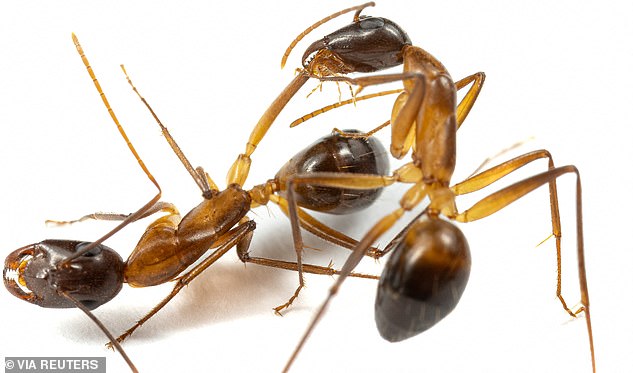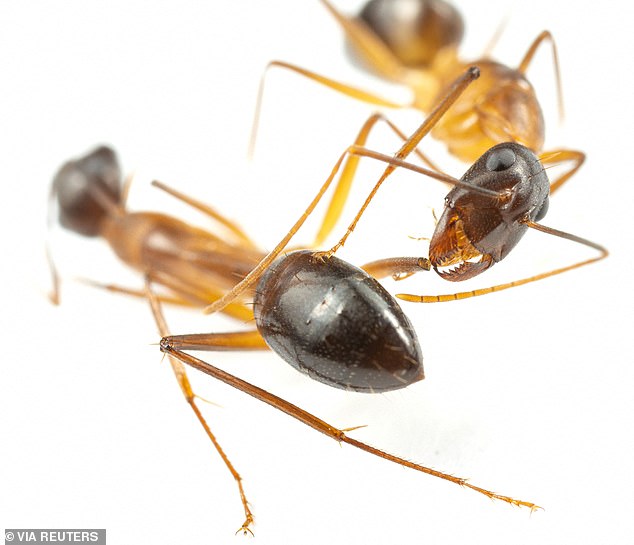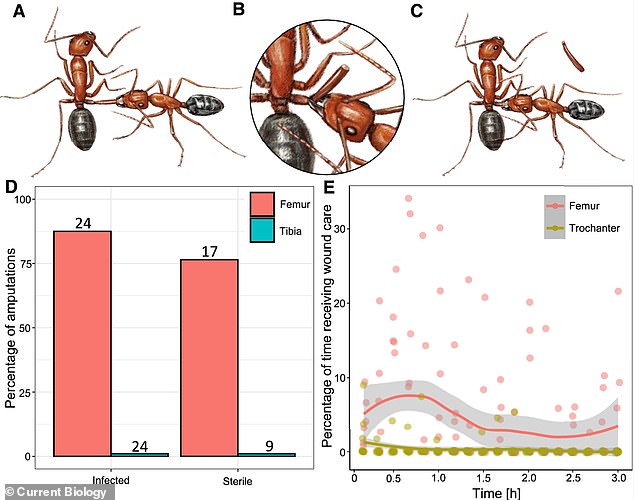Remarkable video shows ants carrying out amputations on nestmates to save them from infections and death
It’s no secret that ants, with their incredible intelligence and organizational skills, are some of the smartest insects on the planet.
But new research shows they can even perform life-saving surgeries on their own kind.
Researchers have discovered that ants perform actions on nestmates to protect them from infection and possible death.
Remarkable video shows healthy ants helping friends who have suffered a leg injury, by cleaning the wound or performing an amputation.
Ants can survive with one or even two missing legs, although they are less able to transport leaves, twigs, or food.
Laboratory tests show that carpenter ants in Florida treat the injured limbs of nestmates, either by cleaning wounds or by amputating (see image)
The new research was led by Dr. Erik Frank, a behavioral ecologist from the University of Würzburg in Germany, and published in Current biology.
“The fact that ants can diagnose a wound, see if it’s infected or sterile, and then treat it based on that with other individuals over an extended period of time – the only medical system that can compete with that is the human system,” Dr. Frank said.
He and his colleagues specifically studied Florida carpenter ants (Camponotus floridanus), a common, brown species native to the southern US state.
In laboratories at the University of Lausanne in Switzerland, researchers cut some ants in their right hind legs, putting them at risk of infection.
The team observed the behavior of their nestmates for about a week and filmed them up close.
They found that littermates either cleaned the wounds with their mouthparts only, or completely amputated the leg after cleaning.

Two carpenter ants, Camponotus fellah, are seen in this undated photo taken in a laboratory at the University of Lausanne in Switzerland. The ant on the right is licking the wounds on an injured leg of the other ant

The research team found that the ants’ choice of care was tailored to the type of injury they had. Here, the ant on the right is caring for the leg wound of the ant on the left
Surprisingly, the ants appeared to assess the injury to determine what procedure to perform, much like a licensed physician assessing a patient.
When an ant injured a leg at a leg segment, the femur, its nestmates would amputate the leg by biting it off.
But if the injury was in the shin, a segment further away from the body, the insects focused primarily on cleaning the mouth.
In both cases, nestmate intervention resulted in a much greater chance of survival for ants with infected wounds.
In injuries to the femur, where the leg was always amputated, the success rate was approximately 90 to 95 percent.
For the tibia, where no amputation occurred, a survival rate of 75 percent was still achieved.
“This is in contrast to the survival rates of less than 40 and 15 percent, respectively, for untreated infected abrasions of the femur and shin,” Dr. Frank said.
The preferred method of wound care is thought to be related to the risk of wound site infection.
Micro-CT scans of the thigh showed that it is largely muscle tissue, suggesting that it plays a major role in pumping blood to the rest of the body. The risk of fatal infection from a thigh injury is therefore likely to be greater.

This graphical summary shows amputation and wound care behavior in Florida carpenter ants (Camponotus floridanus)
Ants are often described as the most intelligent insects in the world and may even possess some degree of self-awareness.
However, the researchers believe that the ability to help a littermate is innate and an “innate behavior.”
“Ants’ behavior changes depending on the age of an individual, but there is little evidence that they learn from this,” said lead researcher Laurent Keller of the University of Lausanne.
Wound care in ants is not entirely new. A 2023 study found that another species, Megaponera analis, uses a specialized gland to inoculate wounds with antimicrobial compounds that should suppress potential infection.
According to the authors of this new study, Florida carpenter ants are unique in that they lack such a gland and therefore use only mechanical means to treat their nestmates.
“When we talk about amputation behavior, this is literally the only case of advanced and systematic amputation of an individual by another member of its species in the animal kingdom,” Dr. Frank said.
